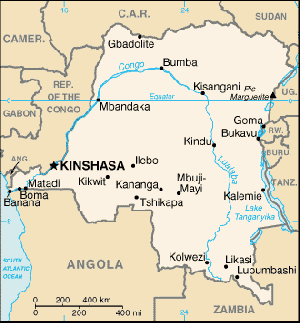Kinshasa (Democratic Republic of the Congo)
Located at the site of what once was a small fishing village on the banks of the Zaire River, Kinshasa has known phenomenal growth. Named Leopoldville by colonial rulers in honor of the Belgian king, its traditional African name was restored after political independence was gained in 1960. The city's population of some 300,000 people in 1960 has grown to more than 3 million in 1986 and about 7.6 million in 2005 and continues to mushroom, reflecting the powerful urban drift which characterizes many other areas of the underdeveloped world.
As long as church program and policy making still lay in missionary hands, inter-mission comity arrangements were respected. This limited Mennonite church planting to the three rural provinces of original assignment. Once such issues became the agenda of national church leaders, however, these former agreements were dismissed as no longer relevant and determined effort was made to locate Mennonites who had migrated to the capital and to bring them together for purposes of nurture and the formation of organized churches. In 1987 Kinshasa had 20 congregations of the Communauté des Églises de Frères Mennonites au Congo (Congo Mennonite Brethren Church), 11 congregations of the Communauté Mennonite au Congo (Congo Mennonite Church), and 4 congregations affiliated with the Communauté Evangélique Mennonite (Evangelical Mennonite Church).
Both the Africa Inter-Mennonite Mission (AIMM) and the Mennonite Brethren Board of Missions and Services (BOMAS) maintained missionary personnel in Kinshasa who provided support services for their church and expatriate personnel located in the interior regions of Congo. AIMM also maintained a missionary children's hostel in the city.
There was a three-year pastoral institute in Kinshasa (Institut Supérieur Théologique de Kinshasa [Superior Institute of Theology in Kinshasa]) to which AIMM and BOMAS have contributed heavily in the past. Originally launched by a group of 12 missions, by 1987 the participating groups had gradually been reduced to 5, among which AIMM and BOMAS were numbered. Both Mennonite Boards continued to provide missionary teaching staff for the school. All three Mennonite Churches of the Congo sent students there for training. AIMM has also across the years contributed missionary personnel to the staff needs of a large inter-mission press and publishing house (CEDI) in the city. The Mennonite Central Committee has on occasion provided staff people for the projects of the Eglise du Christ au Congo (Church of Christ of Congo), the national church federation to which the three Mennonite groups belong, which has its headquarters in the capital.
| Author(s) | James E Bertsche |
|---|---|
| Date Published | 1990 |
Cite This Article
MLA style
Bertsche, James E. "Kinshasa (Democratic Republic of the Congo)." Global Anabaptist Mennonite Encyclopedia Online. 1990. Web. 26 Apr 2025. https://gameo.org/index.php?title=Kinshasa_(Democratic_Republic_of_the_Congo)&oldid=172336.
APA style
Bertsche, James E. (1990). Kinshasa (Democratic Republic of the Congo). Global Anabaptist Mennonite Encyclopedia Online. Retrieved 26 April 2025, from https://gameo.org/index.php?title=Kinshasa_(Democratic_Republic_of_the_Congo)&oldid=172336.
Adapted by permission of Herald Press, Harrisonburg, Virginia, from Mennonite Encyclopedia, Vol. 5, pp. 491-492. All rights reserved.
©1996-2025 by the Global Anabaptist Mennonite Encyclopedia Online. All rights reserved.

